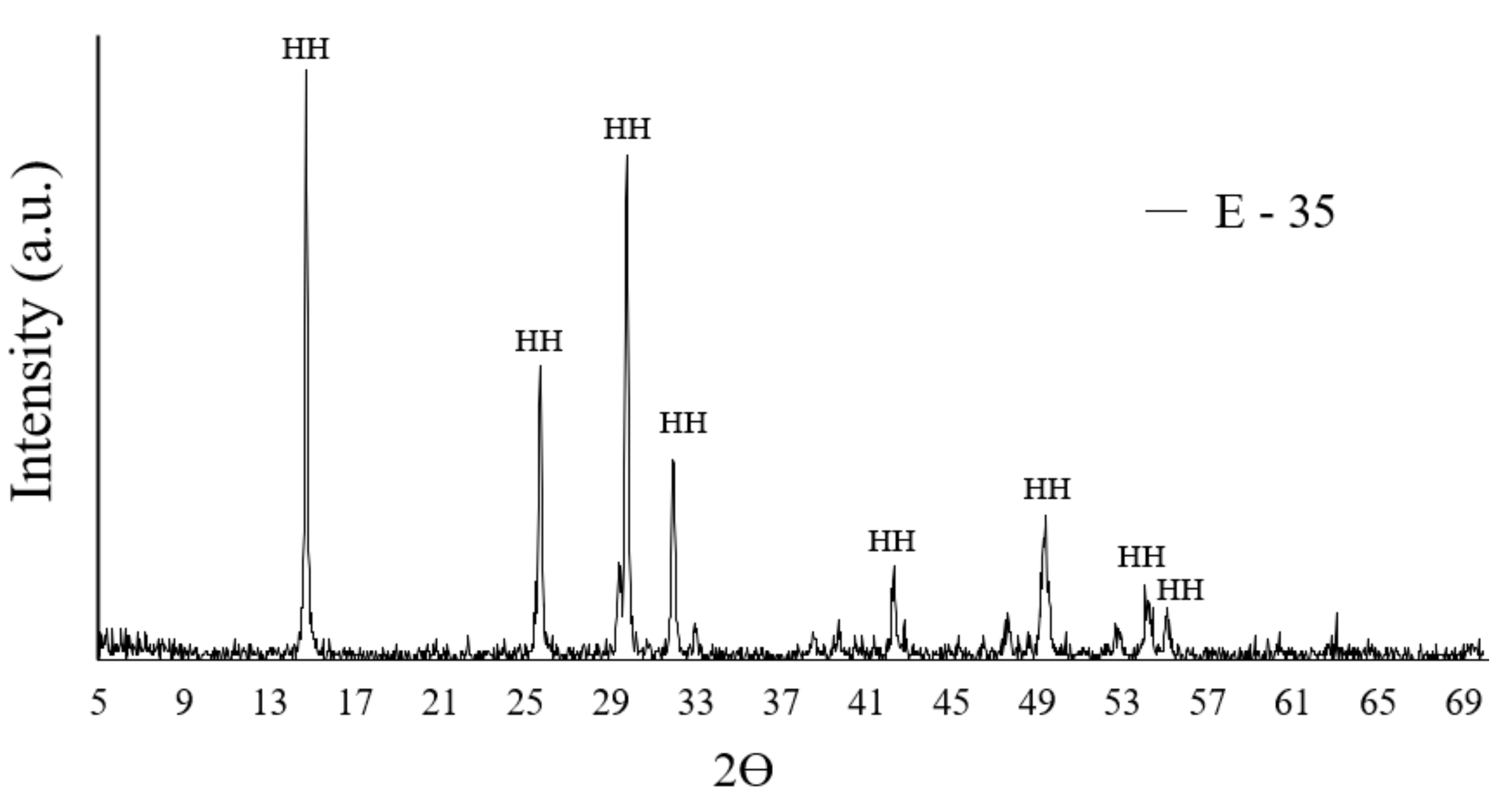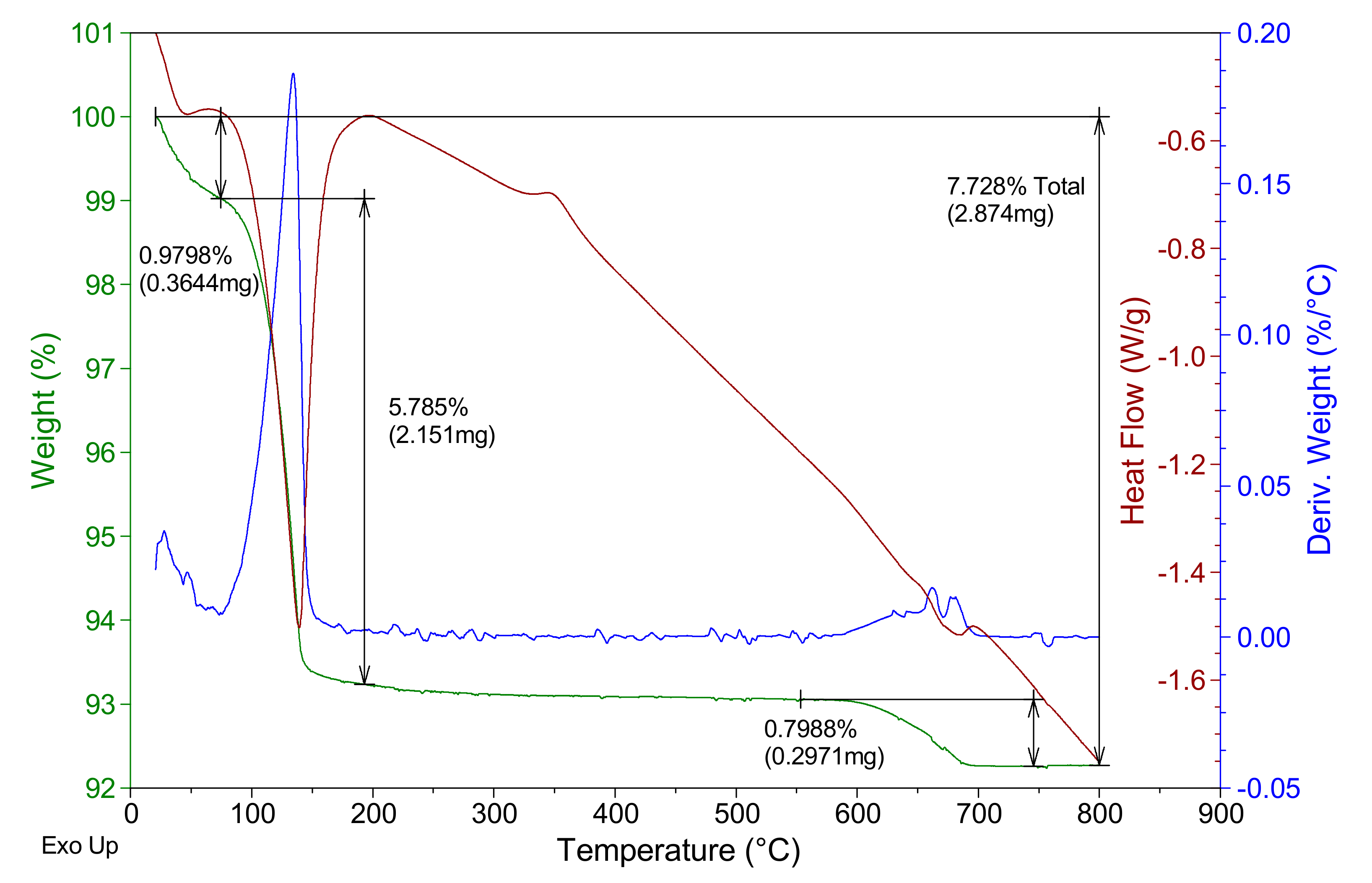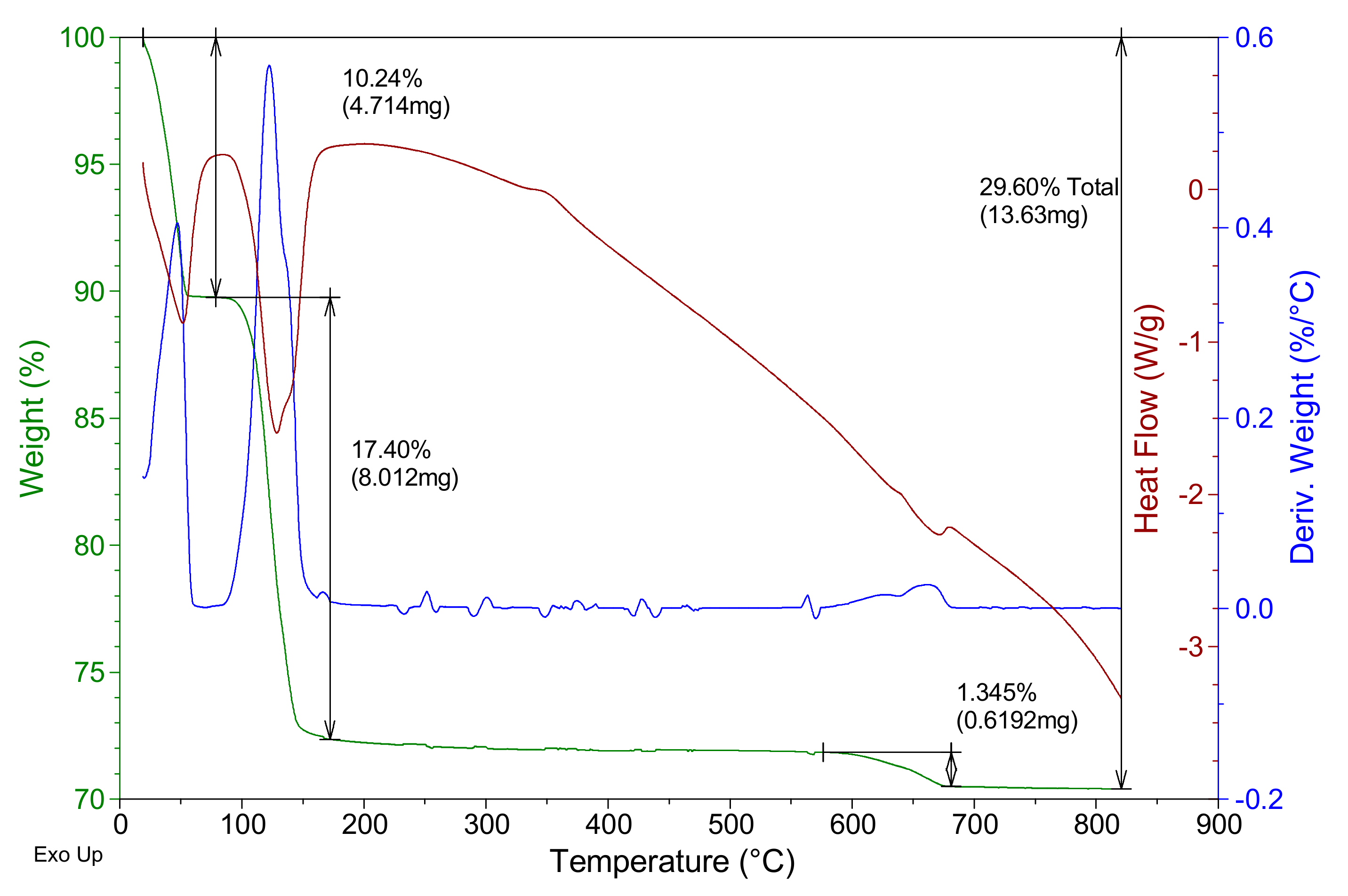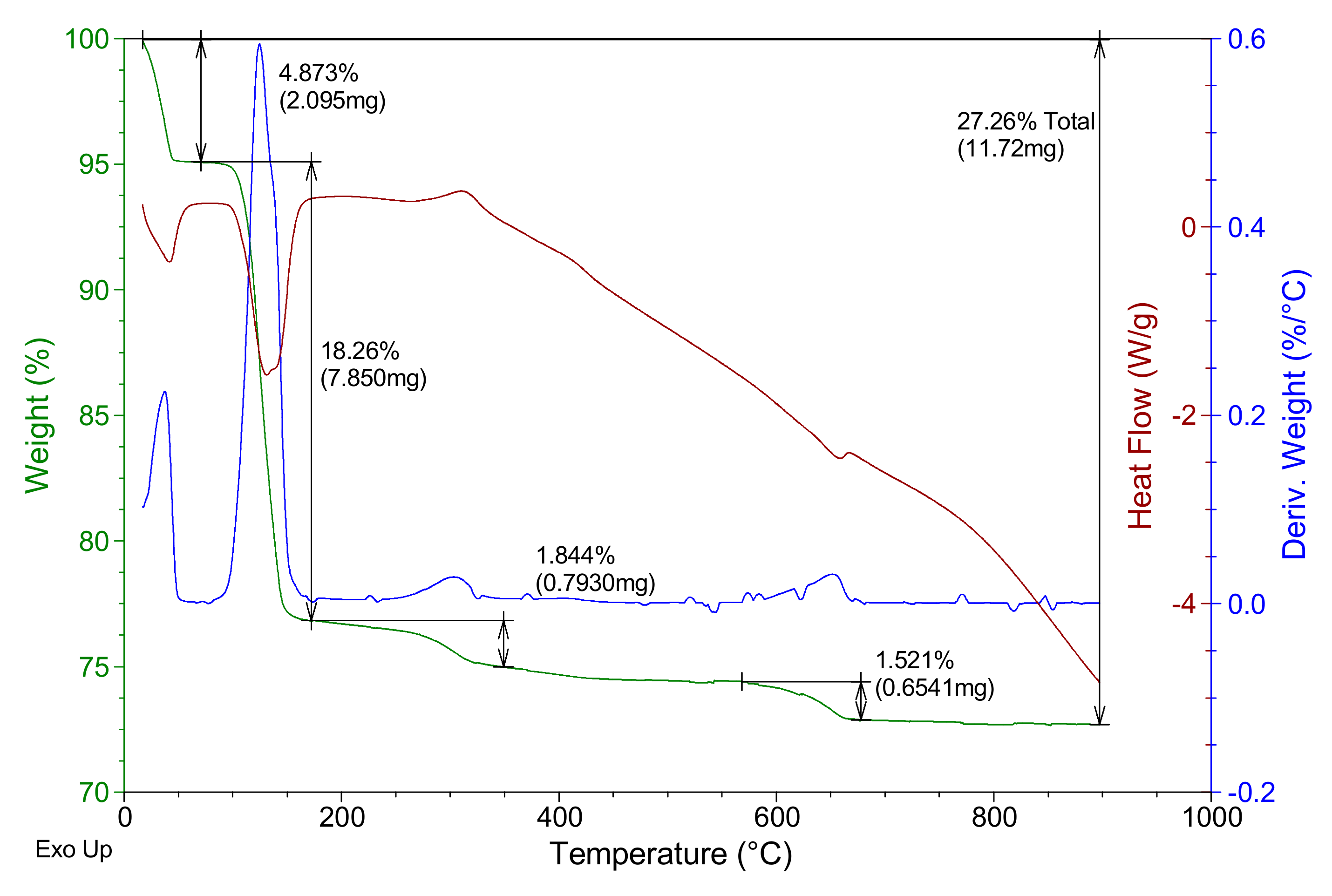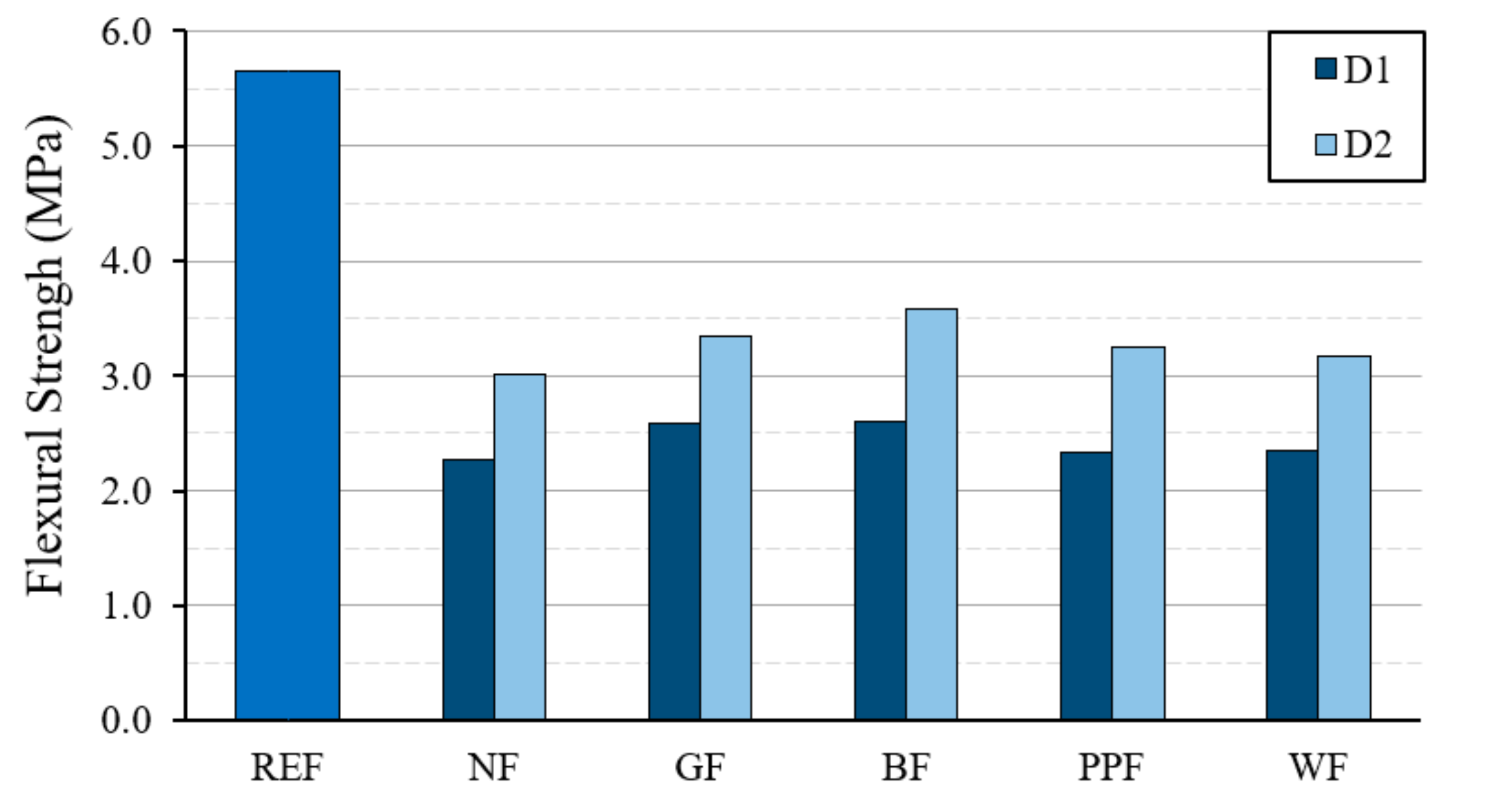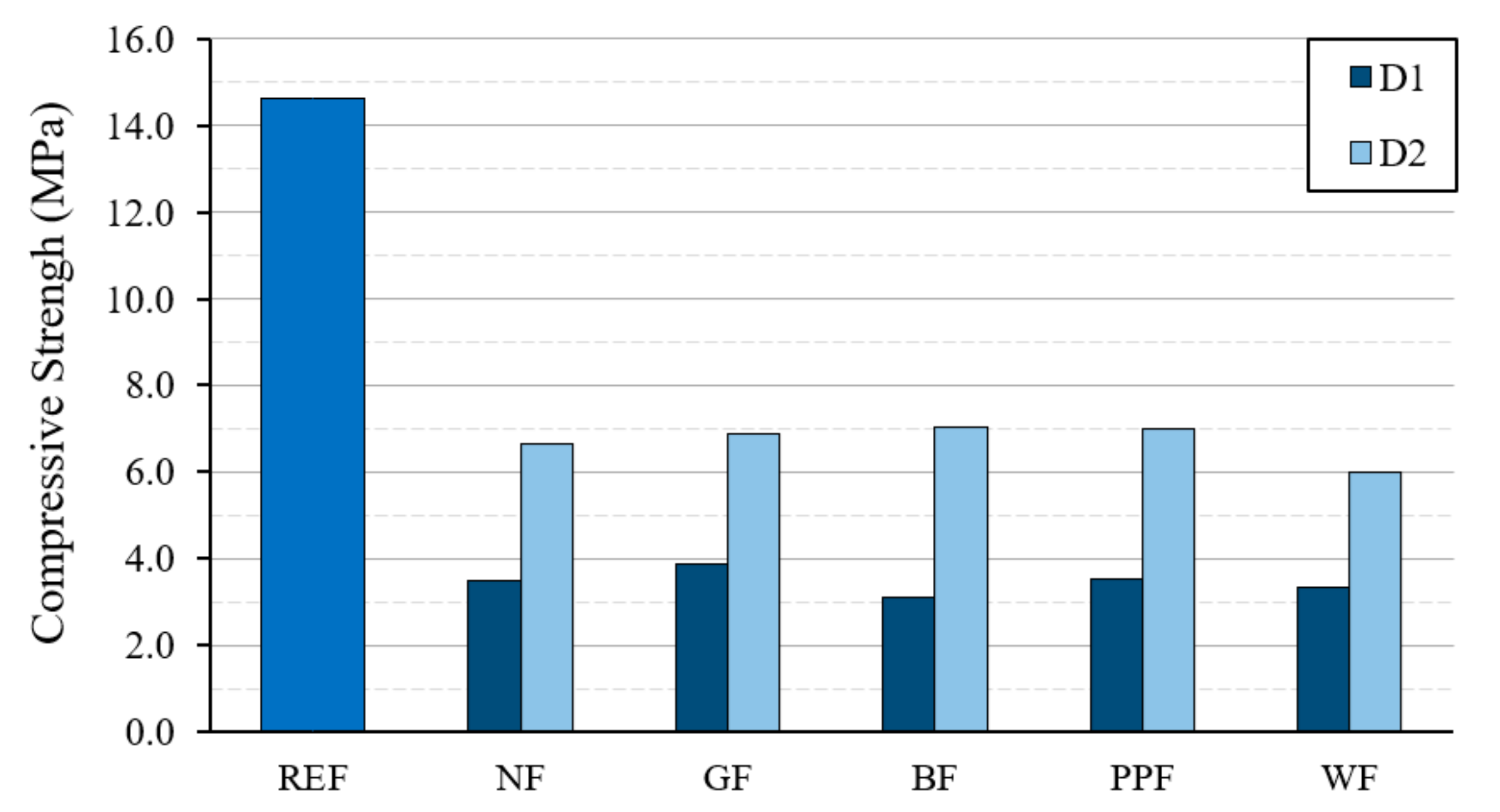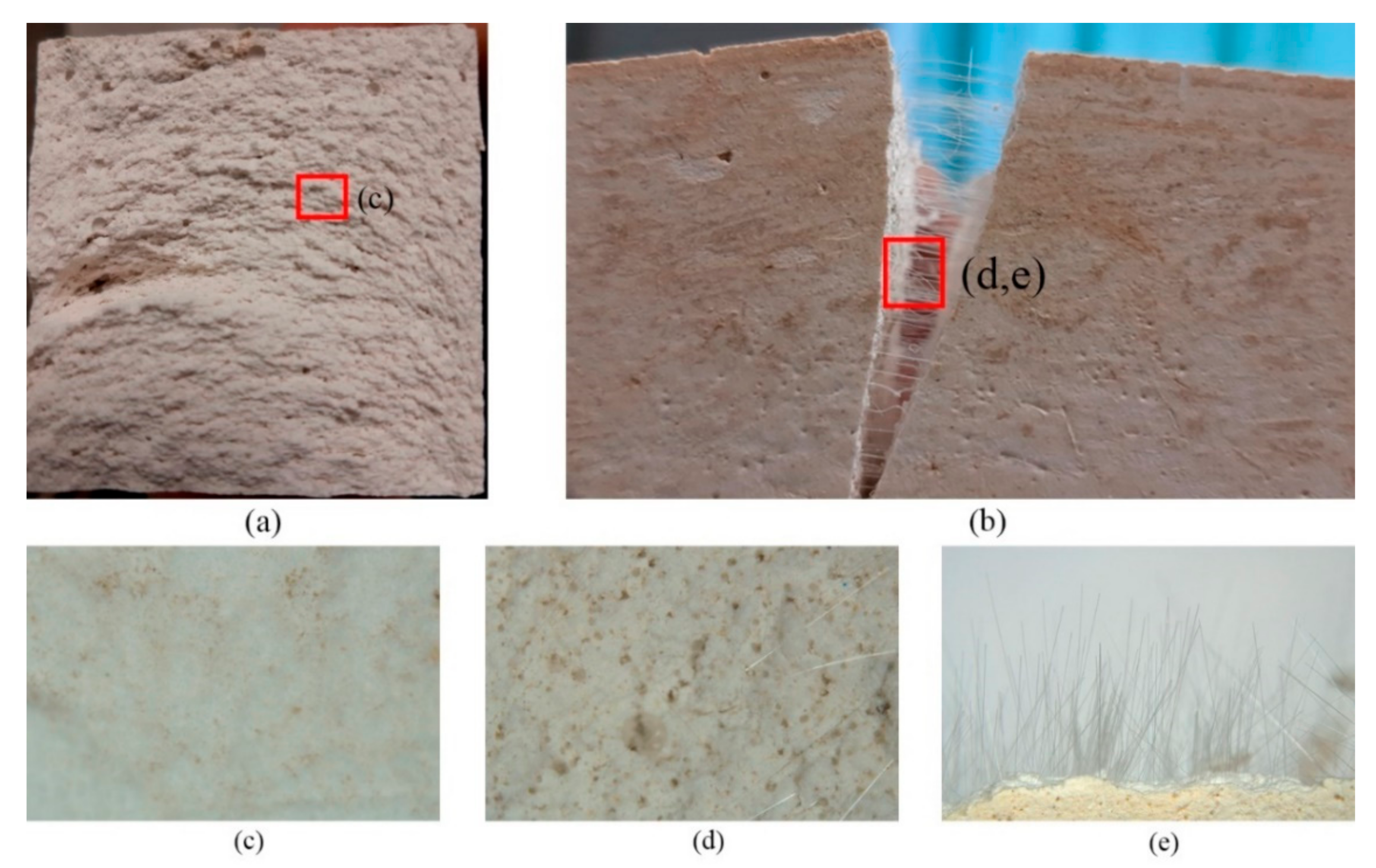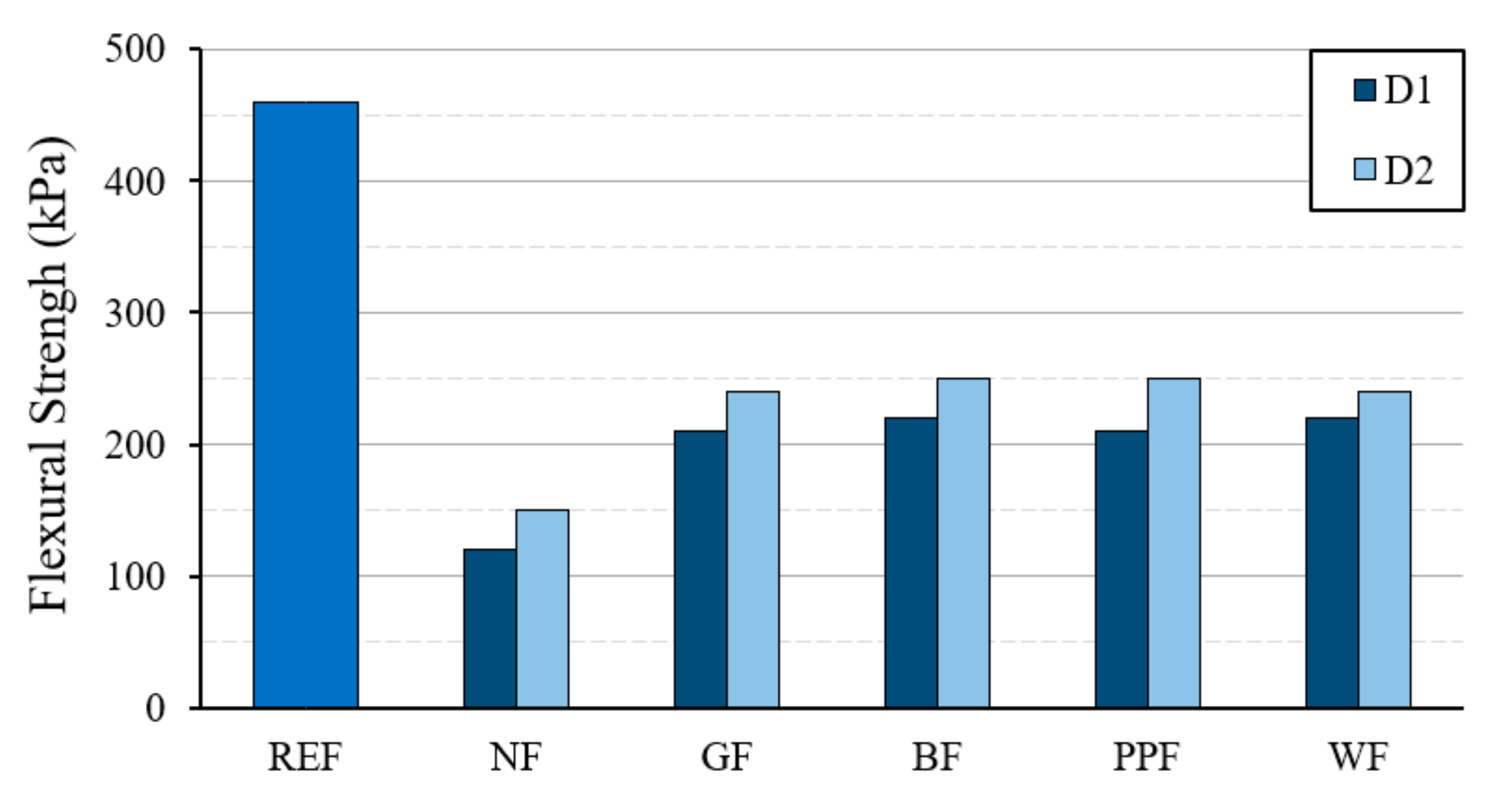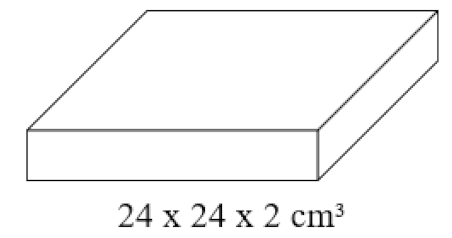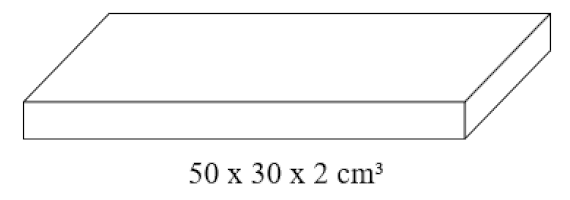3.1. Physical–Chemical Characterization
The X-ray diffraction analysis of the reference and lightened plaster specimens with a higher content of polymeric compound is shown in
Figure 3.
The diffractograms in
Figure 3 show that both samples present a similar profile in terms of the location of the peaks corresponding to the gypsum dihydrate [
49], although it is true that the intensities obtained for the peaks of the lightened plaster sample are greater than in the reference sample.
The thermogravimetric analysis of the reference plaster specimen represented in
Figure 4 shows three mass losses, all of them corresponding to endothermic reactions. The first corresponds to the loss of physically bound water, at a temperature below 100 °C, with a maximum at approximately 47 °C. In the temperature interval of 75–175 °C, the second mass loss occurs, with a maximum at 122 °C. This second loss presents a shoulder, with a maximum at approximately 137 °C. The second mass loss is due to the dehydration of the calcium sulfate dihydrate formed in the reaction of the raw material calcium sulfate hemihydrate with the mixing water used in the specimen preparation (according to Equation (1)). The shoulder is due to the dehydration of the formed hemihydrate in the second mass loss (according to Equation (2)). The figure shows, as in the raw material gypsum of
Figure 2, the transition phase from soluble to insoluble anhydrite, with a maximum at a temperature of 348 °C, and the fourth mass loss in the range 550–700 °C corresponding to thermal decomposition of additives present in the E-35 gypsum raw material, as seen in
Figure 2.
Regarding the thermogravimetric analysis of the lightened plaster sample collected in
Figure 5, and compared with the reference test piece, the same thermal events are observed with similar numerical values in terms of the value of the mass losses of each process, except for the loss of free water mass. In the lightened specimen, this value is less than 5%, while in the reference specimen, it is around 10%. It should also be considered that the phase transition to soluble anhydrite occurs at a slightly higher temperature in the lightened sample and is seen more diffusely. Additionally, in the lightened plaster sample, a fourth loss of approximately 1.8% by weight can be seen, occurring at temperatures between 200 and 400 °C, with a maximum around 305 °C, and which corresponds to an exothermic reaction. This mass loss can be associated with the thermal decomposition in air atmosphere of the polyvinyl compound used in the formulation [
50,
51].
3.2. Physical–Mechanical Characterization
Firstly,
Table 5 shows the results of the test for the determination of the setting start time using the Vicat needle method, as it is the most commonly used procedure to determine this property in plaster materials [
52].
As can be deduced from the analysis of
Table 5, the batches with the incorporation of the polymeric compound presented setting initiation times that were longer than the reference sample. Thus, the designed material permits an increase in the application time and its workability.
As documented in the literature [
43,
51], the reaction of borate ions with polyvinyl polymers gives rise to the formation of a three-dimensional network of cross-linked polymeric chains, between which part of the solvent would be trapped, in this case, the mixing water. In this way, the start of the water–hemihydrate hydration reaction to form calcium sulfate dihydrate would be delayed, a reaction responsible for the setting of the gypsum and its mechanical properties, due to the greater difficulty of water in accessing the hemihydrate particles. This would account for the longer setting time observed experimentally for the specimens that incorporate polymer, this delay being greater in the D1 formulation which incorporates a greater amount of polymer.
On the other hand,
Table 6 shows the results obtained in the adhesion tests, surface hardness and the actual density of the samples.
Table 6 shows how the batches made with the type D2 dosage had lower adhesion values and greater surface hardness than the type D1 batches, all of them lower than the values presented by the reference specimen. It also shows how the addition of fibers has not led to a significant improvement in surface hardness, and even worsened the adherence resistance of the tested material. However, it should be noted that this decrease in the adhesion values would not be limiting since the new plaster material developed in this research is specially designed for use in the preparation of precasts. On the other hand, the significant decrease in density produced by the incorporation of the polymeric compound during kneading can be seen with respect to the density of the reference specimen, in such a way that, in type D1 and D2 mixes, density decreases of over 22% and 12%, respectively, have been achieved in all the cases analyzed. This decrease in density is maintained in all the specimens that incorporate fibers.
The lower density values for D1 and D2 samples compared with the reference are probably due to their higher porosity compared with the reference. This porosity is originated by the CO2 bubble formation during the mass preparation due to the reaction of sodium bicarbonate with acid medium provided by the boric acid solution. These gas bubbles leave the mass, causing voids in the final material and hence a porous structure. The higher proportion of both sodium bicarbonate and boric acid in the D1 series would account for the large quantity of CO2 that evolved, and therefore a higher porosity and consequently less density compared with the D2 series.
Additionally, the three-dimensional network formed by the vinyl polymer–borate ion system during the preparation of the specimens could contribute to the higher porosity of D1 and D2 samples compared with the reference. This large volume network would cause the dihydrate particles to be physically further apart from each other, not only during the preparation of the specimens, but also once the structure has been consolidated after drying. This expanded arrangement of the dihydrate particles would cause a higher porosity, and therefore a lower density, of the polymer specimens with respect to the reference sample and, in turn, a higher proportion of polymer and boric acid solution in sample D1, and therefore a greater extension of the three-dimensional network, giving rise to a density lower than D2.
To test how this material reacts to water, a water absorption test by capillarity has been carried out for 10 min in previously dried 4 × 4 × 16 cm3 prismatic specimens. It was observed how traditional plasters (REF) absorb up to 17% of their weight in water. On the other hand, type D1 dosages absorb 26% and type D2 22% of their weight in water. In this way, it can be said that the water absorption is greater in the case of the lightened specimens, mainly due to their greater porosity.
Figure 6 and
Figure 7 show the results obtained for the values of the mechanical resistance to flexural traction and compression of the different dosages used. These results correspond to the tests carried out on standard RILEM 4 × 4 × 16 cm
3 specimens.
As can be seen in
Figure 6, the new lightened plaster material presents lower flexural strength values than the reference test piece, with the D2 type dosage obtaining better performance compared to the D1 type dosage. It can be seen how the use of reinforcing fibers makes it possible to slightly improve the flexural strength and delay the effect of superficial cracks in accordance with previous studies [
53,
54]. The batches with the incorporation of basalt fiber were the ones that presented higher resistance values compared to the other reinforcing fibers used. However, in all cases, strengths greater than 2 MPa were always obtained. After this test, although all specimens with fiber improved their strength, synthetic fibers were better than natural wood fiber.
Regarding the compressive strengths of the designed plaster material shown in
Figure 7, it can be seen that the mixes made with the type D2 dosage also presented higher values than the type D1 mixes. The incorporation of fibers did not cause a significant improvement in the resistance to compression, although it can be observed how the kneaded mixture with the addition of synthetic fibers obtained values slightly higher than the dosages with the incorporation of wood fiber. In any case, all the dosages used exceeded 3 MPa of compressive strength.
Figure 8 shows some images obtained by scanning electron microscopy. These are presented to help understand the internal structure of the material developed in this investigation.
Figure 8a shows the section of a lightened specimen obtained after carrying out the flexural test. It is clear how the release of CO
2, generated from sodium bicarbonate in an acid medium provided by the boric acid solution, favors the formation of a banded structure which grows convexly and perpendicular to the surface. This anisotropic structure generates preferential directions of failure in flexural and compression tests.
Figure 8c shows a microscopic enlargement of the surface of the material, where its soapy texture can be appreciated.
Figure 8b,d,e show the flexural break of a specimen lightened and reinforced with polypropylene fibers. It can be observed how the material remains together once the break occurs as a result of the internal cohesion caused by the fibers, and also the good adhesion between the lightened plaster matrix and the reinforcing fibers.
On the other hand,
Figure 9 shows the results derived from the pure bending test on plates with dimensions of 50 × 30 × 2 cm
3. These tests indicate the technical feasibility of the plaster material developed to be used in the preparation of precasts, which, together with its lower density compared to traditional plaster panels, improves labor yields. In this way, the typology of prefabricated works elaborated in this study reduces costs and execution times [
55].
As can be seen in
Figure 9, the incorporation of reinforcing fibers in the plaster matrix has a positive effect on the mechanical behavior of the lightened plaster material, which is in agreement with the results obtained by other researchers [
56]. It can be seen that in all the dosages made with the incorporation of fibers, the flexural strength exceeded 200 kPa. In addition, in the specimens made with these dimensions, the differences between strengths of the D1 and D2 type dosages were less pronounced than in the previous flexural and compression tests, obtaining slightly higher results for the D2 type dosage. The reference dosage reached values of flexural strength of 460 kPa, a value three times higher than that reached in the lightened plaster material without fiber reinforcement. Having obtained these results, it is possible to develop plasterboards and ceilings for their use in buildings.
Another of the most important qualities of plaster materials is related to comfort and habitability [
55]. In
Figure 10, the results obtained for the thermal conductivity values in the different dosages used are shown.
Figure 10 shows how the thermal conductivity of all the dosages made with the lightened plaster material were lower than those obtained by the reference plaster dosage. Type D1 dosages presented lower thermal conductivity values than type D2 dosages. The best results were obtained in the D1-GF type dosages, whose thermal conductivity value is up to 30% lower than that obtained for the reference plaster material. However, it should be noted that, except for this case, lightened specimens without fibers have lower thermal conductivity values than specimens containing fibers.
Finally, the mechanical and thermal properties of the D1 and D2 series can be explained based on the same concepts of the porous structure already presented. Thus, the higher porosity already mentioned in the samples with PVAc, sodium bicarbonate and boric acid compared to the reference would account for the lower mechanical properties, lower surface hardness and lower thermal conductivity, with the decrease in these properties being more pronounced in the D1 series that incorporates a higher quantity of all of these compounds in the formulation.
3.3. Statistical Analysis
To carry out the statistical analysis, the suitability of the sample for an analysis of variance (ANOVA) must be verified. The assumptions to be tested to apply an ANOVA are: (1) the K samples are independent; (2) the populations all have the same variance (homoscedasticity); and (3) the populations present a normal probability distribution [
56]. The results obtained are shown in
Table 7.
As can be seen in
Table 7, it has been verified whether the properties to be included in the analysis maintain a normal probability distribution using the Kolmogorov–Smirnov test. It is clear that, with the exception of thermal conductivity, the test statistic presents statistical significance (
p < 0.001), so the null hypothesis is rejected, and it is stated that adherence, density, surface hardness, resistance to compression and flexural strength do not meet the assumptions for performing the ANOVA analysis. Next, the homoscedasticity of the thermal conductivity variable has been verified using the Levene statistic, which, as can be seen in
Table 8, is statistically significant (
p < 0.001), so the assumption of equality of variances of the variable studied is rejected.
Following this verification, it was concluded that to be able to compare the means of the different properties studied in each of the dosages used, it is necessary to use non-parametric tests [
57]. In this case, the Kruskal–Wallis test has been used for independent samples.
Table 8 shows the confidence intervals for each dosage and property studied. The dosages with the best results are indicated with the symbol (↑). This was verified with the mean values for which there are statistically significant differences, indicated with (*). In the adherence property, D1-NF presents the highest mean value (0.58 MPa), and the difference of this value with the mean obtained by D1-BF (0.15 MPa) is statistically significant for a confidence level greater than 99% according to the results of the Kruskal–Wallis test. In the case of density, the best value is obtained by D1-NF (842.98 kg/m
3), although N1-PPF manages to reduce the value further (840.50 kg/m
3), a difference that is not statistically significant. Regarding hardness, the best result is obtained for D2-NF (74.98 Ud. Shore C), although D2-BF and D2-WF exceeded this value without the differences between the means being statistically significant. The same occurs with the compressive strength, as the best result was obtained for D2-NF (6.60 MPa), surpassed by D2-BF (7.07 MPa) and D2-PPF (7.01 MPa), but the differences observed in
Table 8 are not statistically significant. Regarding the flexural strength, the best result is presented by D2-NF (3.02 MPa), being exceeded by all the dosages with the incorporation of fibers without these differences being statistically significant. Finally, regarding thermal conductivity, the best result is presented by D1-NF (0.10 W/mK), improved only by D1-GF (0.09 W/mK), although this difference is not statistically significant.
